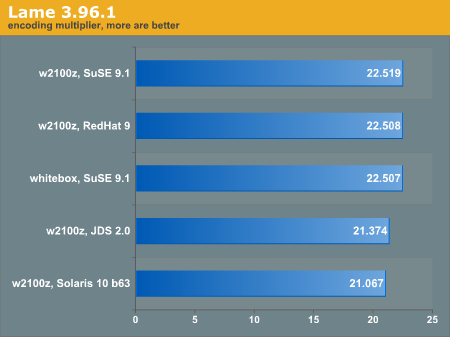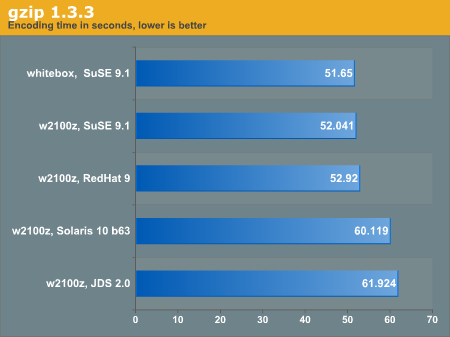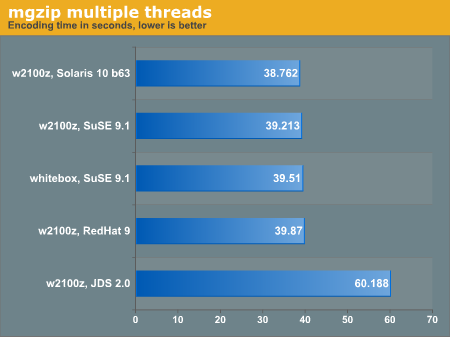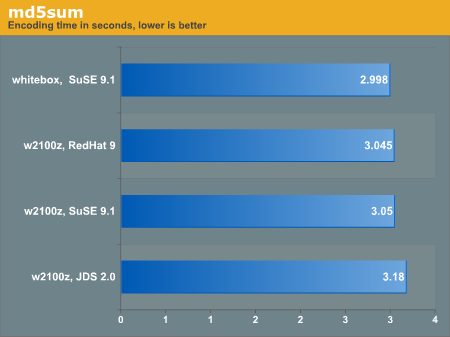Sun's W2100z Dual Opteron Workstation
by Kristopher Kubicki on October 27, 2004 12:05 AM EST- Posted in
- Systems
Encoding Benchmarks
Lame 3.96.1 (GCC 3.4.2)
No workstation roundup would be complete without at least a few simple encoding tests. Below, we have some content creation programs that we would commonly use in intensive workstation applications. We start off with lame 3.96.1, the de facto Linux MP3 encoder. The command to run our benchmark with a 700MB# lame 01.wav -b 192 -m s -h - > /dev/null

We use the same .wav sample file from our previous CPU benchmarks. It's important to note that lame is not multithreaded; it only utilizes one CPU at a time. We attempted to use BladeEnc and the MPI/LAM infrastructure to utilize both CPUs during the encoding, but we actually ended up with poorer performance going from one CPU to two.
Gzip 1.3.5 (Binary)
We took the same 700MB file from the lame encoding test and compressed it using gzip using the following command.# time gzip 01.wav -c >/dev/null

Again, you can see how gzip performed in our previous Linux CPU roundup. Even though we use the same test file, our other Athlon 64 2.4GHz components perform slightly better. There are two main reasons for this: gzip is not a multithreaded compression utility and we receive a performance hit from the SMP kernel, and unbuffered memory on the Socket 939 runs slightly faster.
mgzip 1.2b (GCC 3.4.2)
Using an SMP implementation of gzip called mgzip, we were able to achieve much faster compression times. By default, we expect mgzip to utilize both CPUs. The command used is below:# time mgzip 01.wav -c > /dev/null

When we increased the thread count, we actually achieved even better performance (approximately 27 seconds when specifying 4 threads). By contrast, you can see that the program performs very similarly to gzip when only utilizing one thread (and thus, 1 CPU).
# time mgzip -c -t 1 01.wav >/dev/null

MEncoder 1.0pre5
Finally, we have also included a quick sample of our MPEG2 encoding benchmark. MEncoder 1.0pre5 is part of the MPlayer package and was compiled using GCC 3.4.2 using default flags.










47 Comments
View All Comments
mlittl3 - Wednesday, October 27, 2004 - link
Kris,Yeah, the list I am quoting is a year old because it has the last data for the Virginia tech cluster. There are others now in the top 10 that you mentioned. Even better that some of these are Power chips which the G5 is based on. This news story from Cnet news.com
http://news.com.com/Virginia+Tech+beefs+up+Mac+sup...
talks about the new Mac cluster at Virginia tech with the custom 2.3 Ghz G5 processors. They added 50 more nodes and were able to obtain 2 more teraflops. It will be included in the list to come out in a week or so.
And, Reflex, can you comprehend this:
http://www.apple.com/xserve/
http://www.apple.com/xserve/raid/
These products aren't intended for my mom to check email on. Plus the enterprise (business) apple store (oh my God did I say enterprise and Apple in the same post), sells rack enclosures for 1U systems and a Applecare service parts kit for xserve G5 and xserve raid products. Yes, Apple is a little new to this type of industry, however, Apple has had a server solution ever since the beige Powermac days ( go to www.mactracker.ca for more info). The more they get into it, the better they could get.
I don't know how to respond to your Sun out of business desire. They help AMD and they help competition, both which are good for you and me.
KristopherKubicki - Wednesday, October 27, 2004 - link
mlittl3: Don't forget about the SGI NASA computer now ranked #1 and Blue/Gene L from IBM now #2 or 3. The SGI computer uses Itaniums, the IBM one uses Power chips.Kristopher
Reflex - Wednesday, October 27, 2004 - link
First off, once again, you are misunderstanding what you are looking at. Total number of CPU's is only part of the equation. There are *many* factors that go into the 'most powerful supercomputer' equation. How much memory and what type/speed? How are they linking the individual nodes? What kind of software optimizations have been done, and what software is being used to benchmark it? These rankings are more marketing than reality, and they do NOT answer the question of what the most powerful 2 cpu desktop workstation would be. In other words: Its irrelevant to the discussion at hand. My only point is that you can make a supercomputer out of anything with the right software engineering and equipment, just depends on how much money you wish to throw at the problem.Secondly, I do not know of Sun competing in this market, and I doubt they would care. They sell the Sun name in service, support, and hardware quality, as well as the benefits of their own OS. I am NOT a Sun fan, in fact I honestly have wanted them to die off and let the true innovators take their place. But, the point of this review, and the price on their workstation is that its about more than the hardware at this level, and that is what I am trying to get across to you when you go compare price tags. A difference of a few grand means nothing in a large corporate environment, its the service they are paying for and they know it.
Apple has NO corporate service infrastructure at all, they will not have a replacement server or workstation to a business in a few hours after a failure, they do not have specialists who can assist in integrating their hardware into a server cluster, and they do not offer those types of services for free as part of your purchase. This is why they are NOT in competition with this product, no matter how well they perform.
Can you comprehend this?
mlittl3 - Wednesday, October 27, 2004 - link
Okay, Relfex, you really haven't done your homework. The November 2003 Top 500 supercomputer list was the last time the Viginia Tech cluster was listed (they have been upgrading since then and will be in the 2004 November list). This cluster was made up of consumer level desktop computers at the time the list was compiled. Here is a duplication of the top 10.Earth Simulater - 5120 processors
ASCI Q - 8192 processors
X (Virginia Tech) - 2200 processors (2 GHz G5)
Tungsten - 2500 processors
Mpp2 - 1936 processors
Lightning - 2816 processors (2 GHz opteron)
MCR - 2304 processors
ASCI White - 8192 processors
Seaborg - 6656 processors
xSeries - 1920 processors
First off, none of the top ten are Sun systems. Second, according to your example, the cluster with the least amount of processors should be the best, highest performance processor used for high end computing needs that servers would handle. Let's see. The two least number of processor clusters were an itanium cluster (Mpp2) and a Xeon cluster (xSeries) neither of which performed better than the G5 with just 250 more processors (which was the third smallest). And if I remember correctly, the G5 cluster cost less than the rest of the top 10 (~$10 mill).
What I really want to point out is that the 2200 G5's at 2GHz beat the 2816 Opteron's at 2 GHz. Do I need to do the math for you or can you handle it? What is even more insult to injury is that the Opteron Lightning cluster was made from high performance server/workstation computers and the G5 cluster was made from "desktop" computers as you put it.
phaxmohdem - Wednesday, October 27, 2004 - link
Apples Suck.(I'd much rather eat grapefruit)
Reflex - Wednesday, October 27, 2004 - link
"Well, I guess all you apple-haters' comments that x86 computers are cheaper than apple computers can eat your words."That is why I made a statement about Zealots, and then set out to demonstrate why you were comparing apples to oranges.
Secondly, if you toss enough processors into an array, you can make it a top supercomputer. With enough 8088's you could even make that perform(I'd hate to see the size of that array however). Once again, the Power970 is a *nice* CPU, but that does not mean there aren't more powerful options out there, nor does it mean that it is a good option in all situations. There is an Opteron supercomputer being built that should be tops in the world, for example, but its not really an example of how powerful the Opteron is, its an example of scientists with a large budget and projects that warrant it throwing a lot of CPU's at a problem.
And actually, my point is made with the geForce6800's. That is a consumer level card, and a video engineer will likely remove it in favor of a Quadro or something from 3DLabs or SGI. Just because something can push a lot of polys does not make it a professional level card. Go look up the card in the Sun workstation, it is NOT a consumer level card.
mlittl3 - Wednesday, October 27, 2004 - link
#19, if you don't want to start a Mac/PC flame war then don't write stupid statements like"The problem with the recent Mac article appears to be that it has attracted the zealots to this site in force."
If a site reviews a particular piece of hardware whether it is a Mac or Apple, then anyone interested in the hardware has a right to read it and comment on the article. If a Mac review site did a review on an x86 piece of hardware, I wouldn't bash an x86 enthusiast for reading it and commenting on it.
It seems hardware enthusiasts are like segrecationists from the deap south back in the 50's and 60's. Statements like, "I don't like those Mac hippies hanging around our holy x86 hardware review sites and spoiling the purity of our x86 world" sounds like what you are saying, Reflex.
Anyway, you have not commented on the fact that the Virginia Tech supercomputer cluster of G5's won the third spot on the Top 100 supercomputer lists last November or the fact that Apple G5's are sold with Geforce 6800 DDL video cards to provide enough power to light up two 30" LCD panels for high end workstation applications. Pretty high tech for just "audio/video editing".
Reflex - Wednesday, October 27, 2004 - link
#17: Confused is right. You seem to think that all that goes into a name brand workstation is the hardware. You buy a Sun, you are buying the name, and in Sun's case that means a LOT in the corporate market. Apple's name means nothing there and is not worth a premium over a white box IN THAT MARKET. In the home market, the digital audio/video market, and to some degree desktop publishing market the opposite is true. Its all about what a platform's strengths are.As for that HP vs Apple consumer system you mentioned, you forgot the part where that 2.4Ghz A64 would significantly spank the Mac you compare it to. A 1.8Ghz Mac does not compare with a 2.4Ghz A64 in performance. Granted we can't see how bad the comparison would be due to lack of optimized apps for both platforms, but I'd be shocked if it could do more than a few Photoshop renders faster on the Mac. Compare the price to a 1.8Ghz A64 and you shave a few hundred dollars off that price.
I am not trying to start a Mac/PC flame war here, both have thier strengths and weaknesses. However comparing a *consumer* Mac(despite whether or not you can use it as a workstation) with a corporate targeted workstation is a rediculous comparison, and only demonstrates the lack of experience in the industry of those who would do such a comparison.
Reflex - Wednesday, October 27, 2004 - link
#15: I am very familiar with the PPC970, and I am a regular on Ars. I am NOT bashing it at all. My point is only that its difficult to get a real feel for Apple performance due to Apple's lack of cooperation with tech review sites. We don't really know what is better than what and in which situations.#14: You can say something 'feels' however you want. That does not change anything for a corporate IT buyer. The G5 is NOT marketed to them, the support provided is NOT what they would consider acceptable, and the Apple brand is not taken any more seriously than Packard Bell when it comes to corporate workstations and servers in that market. That is the market the Sun is designed to serve, and its competition are workstations from SGI, HP, and Dell, NOT Apple. Apple's G5 certainly can be considered a workstation if a person wishes to use it as such, however outside of the Audio/Video editing field it is likely not. I have yet to see a company with a legion of Mac's on their desktops that is not either in publishing or art. You can consider *anything* a workstation if thats how you decide to use it, even an iMac.
Sun, however, specifically gears their hardware, software and support to this market. That is why you pay a premium for systems such as this, your paying for more than just the hardware, your paying for the guarantee that Sun offers. So comparing this to a consumer focused G5(just compare those video card choices again if you want to know what is geared to what market), with the support systems, OS options(where is Linux on the G5? How about Win2k3 Server? Yes I know it wont' run, but its an option on the Sun), and ultimatly a OS on the level of Solaris for stability and security. Its just not there.
Macs are good for what they are. But they are not comparable to workstations in this class despite pricing themselves there. In fact, this is more an indictment of Apple than it is of Sun, after all they are selling a consumer product for the price of a corporate workstation...
mlittl3 - Wednesday, October 27, 2004 - link
Reflex, I can turn this "workstatin/server" as you put it into a regular desktop computer if you would like by simply taking away or substituting parts. Let's take out 3 GB of memory, subtract one of the processors and replace the remaining with a 2.4 Ghz Athlon 64, substitute a mainstream video card. This gives us a single processor, 1GB system or "desktop" as you like. I will use an HP system as an exampleHP a750e: $1500
Apple single 1.8 GHz G5: $1645
Wow!!! Almost the same price. Of course, Reflex, you will counter with HP sucks, buy a generic $20 case and power supply, CAS333 generic memory, the 1.8 GHz is slower than 2.4 GHz etc. etc. But as long as a pre-built x86 system (from HP, IBM, whatever) costs about the same as a Apple's computers with similar specs, then you can't complain about price.
Anyway, the Apple dual G5 is not only for the general desktop consumer. Get another clue. Why would a desktop consumer buy a Geforce 6800 Ultra DDL that supports two 30" LCD panels to check email? The only use is for highend workstation graphics for movies, game development, etc. Plus, the desktop versions of the G5 were used in Virginia Techs supercomputer cluster before they were replaced with Xserves. What is the difference between a 1U Xserve and a desktop G5 technlogy wise? In addition, ANY computer can be a workstation or server but you would get crappy performance rendering on a celeron, 256MB computer but you could still do it (some computer companies sell regular Pentium 4 systems and call them workstations).
Stop getting hung up on words. If you know the technology, then you know a dual 2.5 GHz G5 can be a desktop, server, workstation, etc. (Apple even gives you the option to buy OS X server with the desktop version) just like a $8000 Alienware gaming pc can be used as a server if you wanted to.
And thank you for calling me a zealot when all I said was highend Apple computers cost the same as highend x86 desktops/workstations/servers what the f**k ever. Actually, I showed the whitebox x86 as the cheapest. I didn't say Apple is always less money or apple has better performance, etc. Please define zealot for me. I'm confused.